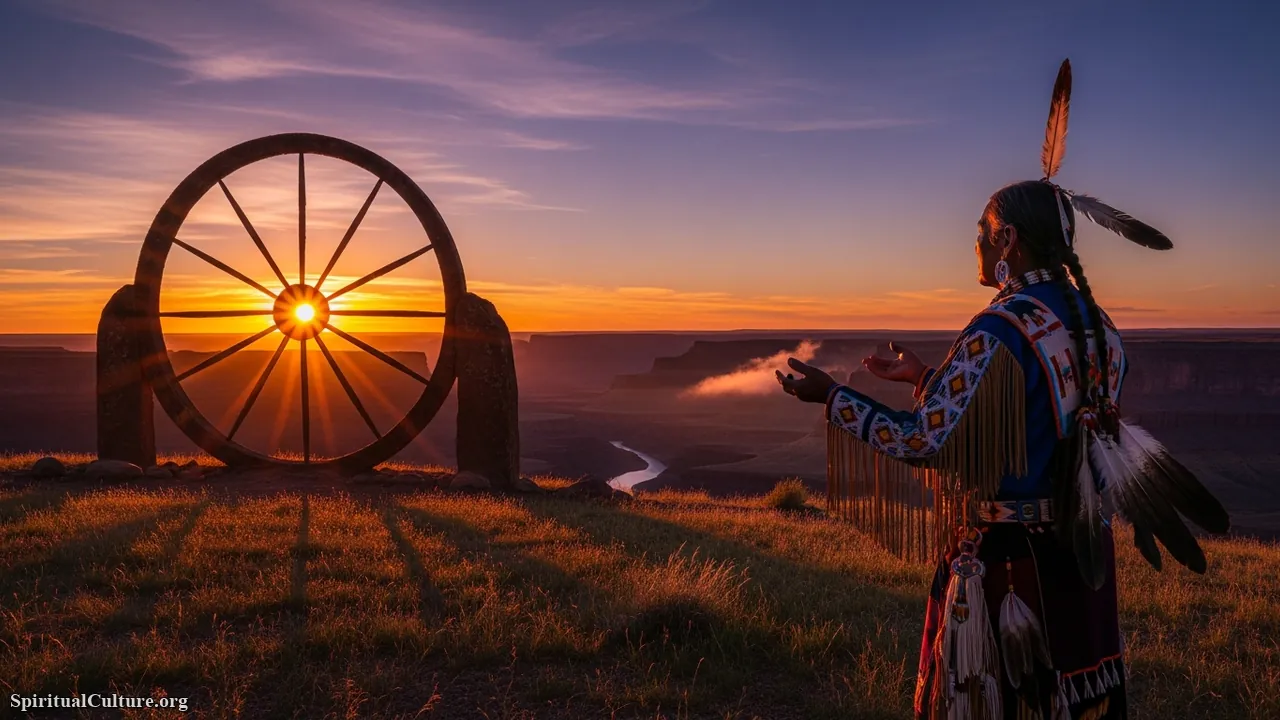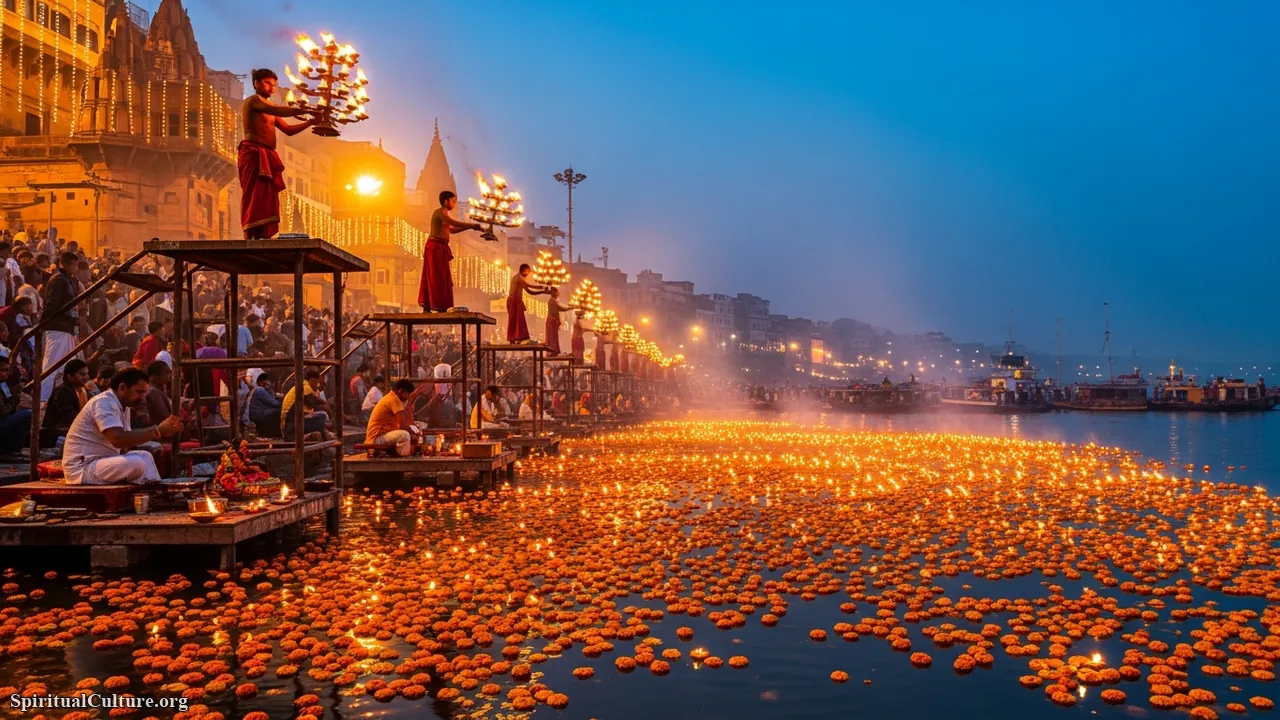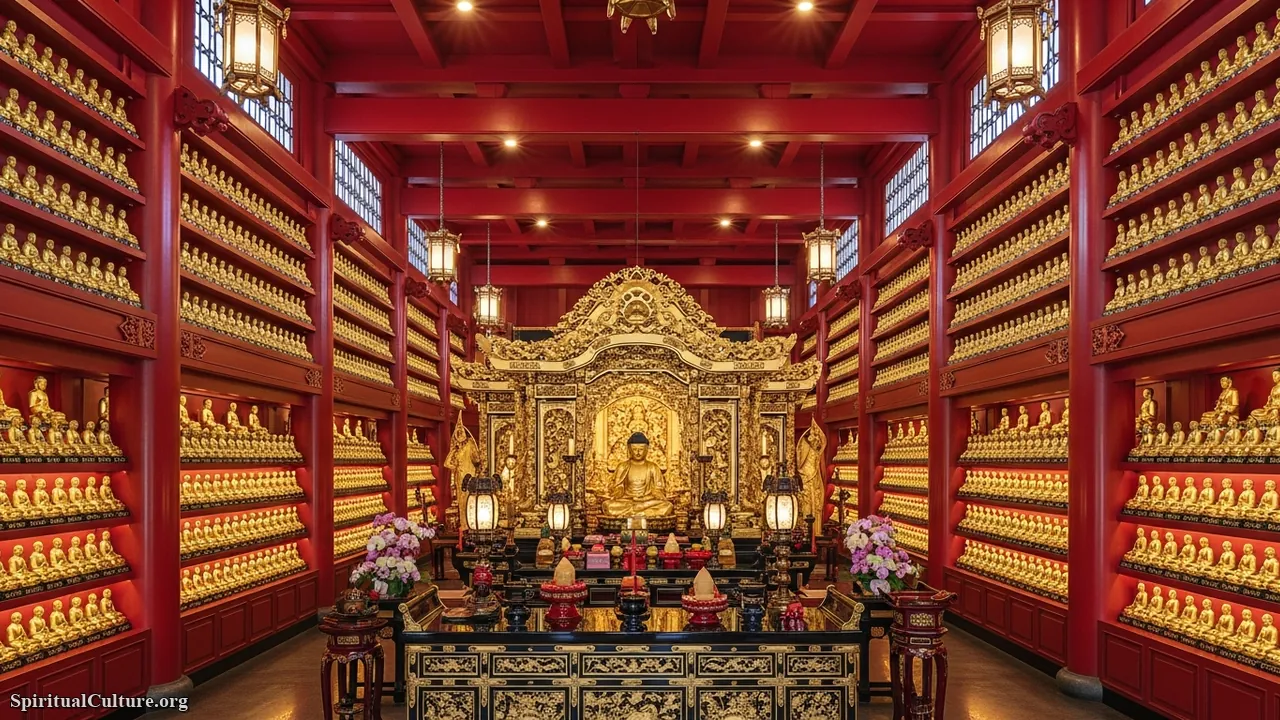Singapore, a dynamic island nation at the crossroads of Asia, is a unique tapestry woven from diverse ethnic threads—Chinese, Malay, Indian, and Eurasian. While the global image often highlights its futuristic skylines and commercial prowess, the true soul of the country resides in its cultural and spiritual landmarks. These sites are not mere historical relics; they are living, breathing epicenters of community, tradition, and profound reverence.
For Spiritual Culture, we go beyond simple visitor numbers to evaluate the lasting spiritual impact, heritage preservation status, and the crucial role these attractions play in maintaining Singapore’s famed multicultural identity. Our ranking reflects the attractions most successful at translating deep historical significance and spiritual purpose into a widely popular and enriching cultural experience for both locals and international visitors.
As of the Current Time of Writing, Singapore continues to champion its cultural continuity, leveraging sites like its historic temples and designated heritage zones to teach the enduring moral and spiritual lessons brought by its founding communities. This Top 10 list is a testament to the nation’s commitment to cultural memory amidst rapid modernity.
Table of the Top 10 Most Popular Cultural Attractions in Singapore (2025 Ranking)
| Rank | Attraction Name | Core Cultural Identity | Spiritual Significance/Heritage Status |
|---|---|---|---|
| 1 | Gardens by the Bay | Nature, Sustainability, and Futuristic Heritage | Symbolic ‘City in a Garden’ Philosophy; Spiritual connection to Nature. |
| 2 | Chinatown Heritage District | Chinese Pioneer and Folk Culture | Home to the Buddha Tooth Relic Temple and Sri Mariamman Temple; Historic enclave of early Chinese settlers. |
| 3 | Singapore Botanic Gardens | National Heritage, Botanical Science | UNESCO World Heritage Site; Oldest garden in Singapore (166 years old). |
| 4 | Little India Heritage District | Indian (Tamil) Pioneer Culture | Home to Sri Veeramakaliamman Temple and Sri Srinivasa Perumal Temple; Spiritual hub for the Hindu community. |
| 5 | National Museum of Singapore | National History and Collective Memory | Oldest museum in Singapore (established 1887); Repository of the nation’s shared stories. |
| 6 | Kampong Glam Heritage District | Malay and Muslim Culture | Home to Sultan Mosque (National Monument); Historical seat of the Malay Sultanate. |
| 7 | Buddha Tooth Relic Temple and Museum | Buddhist Heritage (Tang Dynasty style) | Believed to house a tooth relic of the historical Buddha; Major pilgrimage and reflection site. |
| 8 | Asian Civilisations Museum (ACM) | Pan-Asian Civilisations and Cultural Exchange | Focuses on Singapore’s ancestral cultures, especially those connected to trade and faith. |
| 9 | Haw Par Villa | Chinese Folklore and Moral Education | Macabre but didactic Ten Courts of Hell exhibit; Unique moral park from 1937. |
| 10 | ArtScience Museum | Art, Science, and Human Ingenuity | Iconic lotus-inspired architecture; Explores the human quest for knowledge and creation. |
#10. ArtScience Museum
The ArtScience Museum, instantly recognizable by its striking lotus-inspired architecture at Marina Bay Sands, is more than just a modern exhibition space; it is a profound architectural statement on the convergence of human creativity and scientific inquiry. Established in 2011, it symbolises Singapore’s forward-looking cultural identity, hosting significant international exhibitions that bridge the gap between technology and deep philosophical themes. Its popularity stems from its consistently immersive and visually stunning approach to exploring complex ideas, making profound concepts accessible to a mass audience.
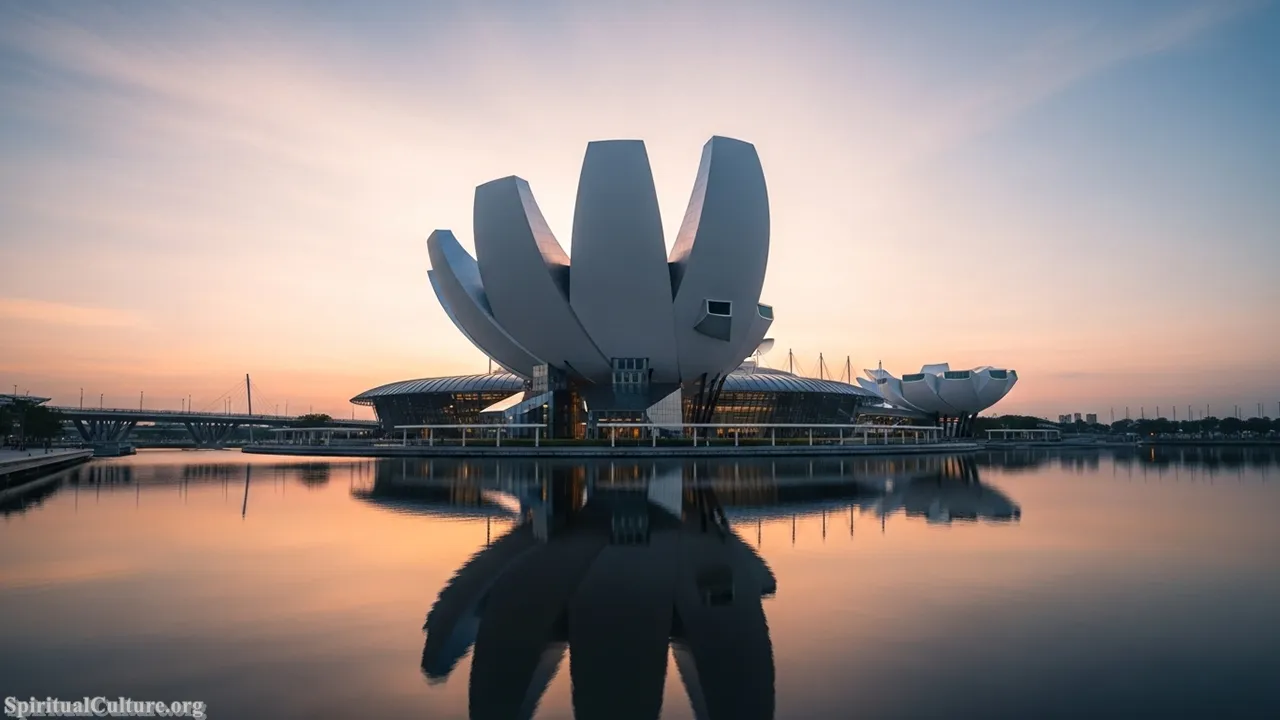
The spiritual impact of the museum is found in its core mission: celebrating human ingenuity as a sacred form of creation. The building itself is designed to harvest rainwater and is often described as an ‘Open Hand,’ symbolising hospitality and the outstretched hand of Singapore to the world of ideas. Its main permanent exhibition, “Future World: Where Art Meets Science,” uses digital installations to create environments for contemplation, subtly encouraging visitors to reflect on the interconnectedness of existence—a modern form of spiritual awe.
Its preservation value lies not in ancient materials, but in its role as a living monument to Singapore’s commitment to innovation and education. The museum embodies the moral lesson that knowledge and imagination are the true wellsprings of progress. By making intellectual curiosity a public attraction, it elevates the pursuit of understanding to a cultural ideal.
Cultural/Spiritual Highlights
- Fingers/Petals designed to channel light into the galleries, symbolising the illumination of knowledge.
- Its design as an “Open Hand” is a spiritual gesture of welcome and receptivity.
- Hosts exhibitions exploring global human themes, such as space, climate, and consciousness.
#9. Haw Par Villa
Haw Par Villa, built in 1937 by the entrepreneurial Aw brothers (creators of Tiger Balm), is a cultural anomaly—an outdoor theme park dedicated entirely to Chinese mythology, folklore, and moral teachings. While perhaps not as pristine as other attractions, its unique, sometimes bizarre, dioramas remain deeply embedded in Singaporean cultural memory. It offers an irreplaceable, tangible link to the popular morality tales and didactic narratives that shaped early 20th-century Chinese immigrant society, drawing visitors seeking a glimpse into this singular aspect of heritage.
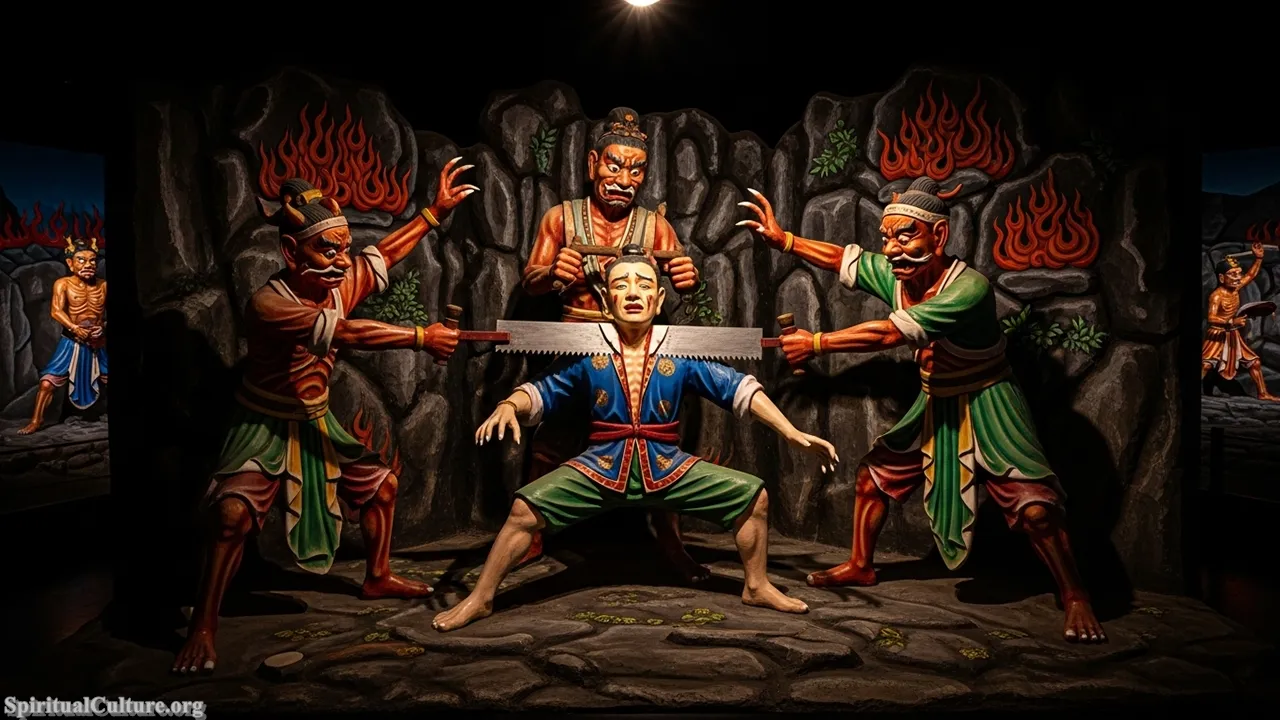
The entire attraction is a massive, three-dimensional spiritual lesson on karma and moral consequence. The infamous “Ten Courts of Hell” section, which graphically illustrates the punishments for vices, is its spiritual centerpiece, designed not to entertain but to instil fear and reverence for ethical conduct. This function underscores its ranking: it is one of the island’s most direct, unwavering attempts at popular moral and spiritual instruction, rooted firmly in traditional Chinese folk religion.
The park’s importance lies in its role as a historical document of immigrant beliefs and the unique vernacular art of the era. It serves as a permanent, if stark, reminder that actions have consequences, a universal moral lesson packaged through the specific cultural lens of the Aw family’s philanthropy. Its preservation ensures the survival of this unconventional, pre-war Chinese cultural landscape.
Cultural/Spiritual Highlights
- Home to the macabre but highly didactic “Ten Courts of Hell” exhibit.
- Features hundreds of dioramas depicting Chinese legends like Journey to the West and The Legend of the White Snake.
- Represents a unique form of 20th-century Chinese entrepreneurial philanthropy and moral education.
#8. Asian Civilisations Museum (ACM)
Strategically located by the Singapore River in a neoclassical building, the Asian Civilisations Museum (ACM) is Singapore’s dedicated institution for exploring the material history of Asia, particularly the ancestral cultures of Singaporeans. Unlike national history museums, ACM focuses on the continent’s vast cultural exchange and the deep connections that defined the region before modernity. Its popularity lies in its role as a regional cultural anchor, offering world-class collections that illuminate the shared heritage that flows through China, India, Southeast Asia, and the Islamic world.
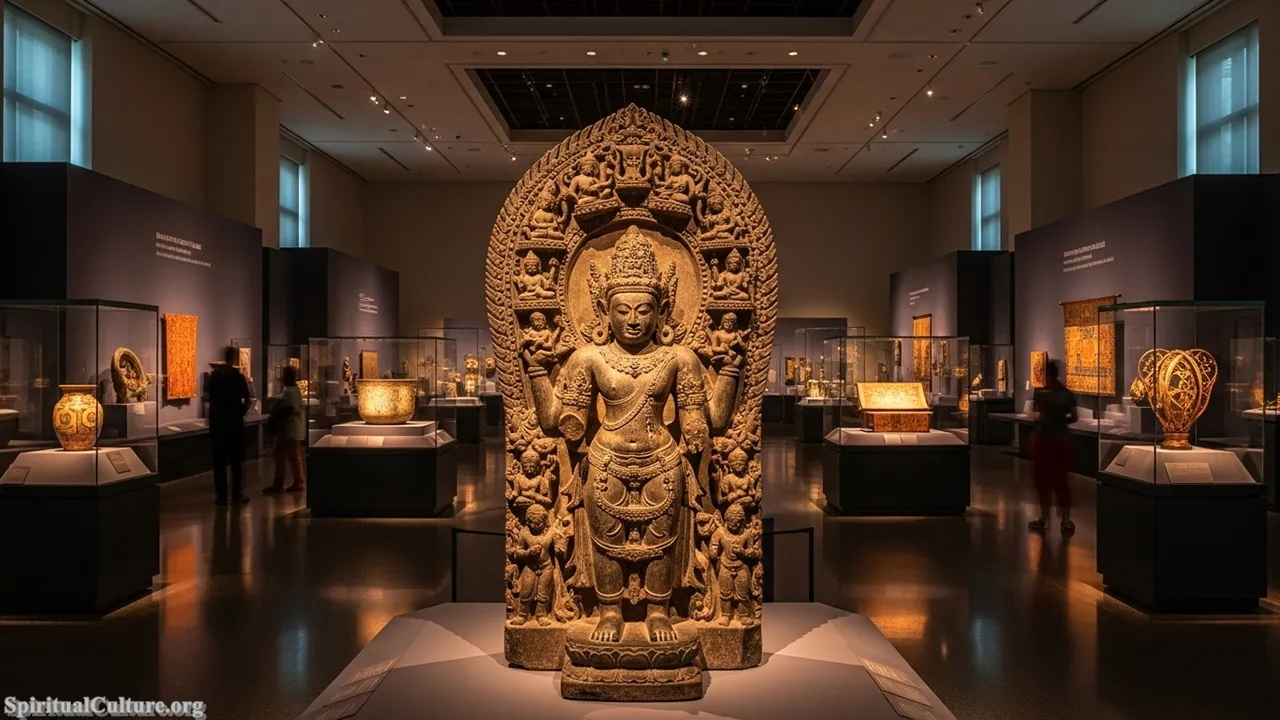
The spiritual impact of the ACM is vast, as its exhibits are primarily dedicated to religious artifacts, ceremonial objects, and the art inspired by faith—from Buddhist statuary and Hindu bronzes to Islamic ceramics and Christian relics. By showcasing the interconnectedness of these spiritual traditions through trade and migration, the museum fosters a humanistic appreciation for religious tolerance. It reveals that the spiritual paths of Asia have always crossed and influenced one another, reflecting Singapore’s own multiracial ethos.
The ACM is crucial for preserving the sense of a shared Asian legacy. Its collection provides the factual evidence supporting the narrative of Singapore as a cultural crossroads, offering a tangible link for Singaporeans to understand their historical place within the larger Asian civilization. This institution teaches the profound lesson that cultural identity is layered, fluid, and built upon centuries of shared humanity.
Cultural/Spiritual Highlights
- One of the few museums in Asia dedicated to the material culture of all major Asian civilizations.
- Key collections include Chinese ceramics, South Asian sculpture, and Peranakan artifacts.
- Fosters spiritual understanding by illustrating the convergence of major world religions across the region.
#7. Buddha Tooth Relic Temple and Museum
The Buddha Tooth Relic Temple, an architectural marvel in the heart of Chinatown, is a relatively new structure—consecrated in 2007—yet it has rapidly become one of Singapore’s most significant cultural and spiritual landmarks. Built in a style reminiscent of the Chinese Tang Dynasty, the temple is meticulously designed to honour the spiritual traditions brought by the Chinese community. Its primary draw is the sacred relic believed to be a tooth of the historical Buddha, an object of immense veneration that draws devout Buddhists and curious visitors from across the globe.
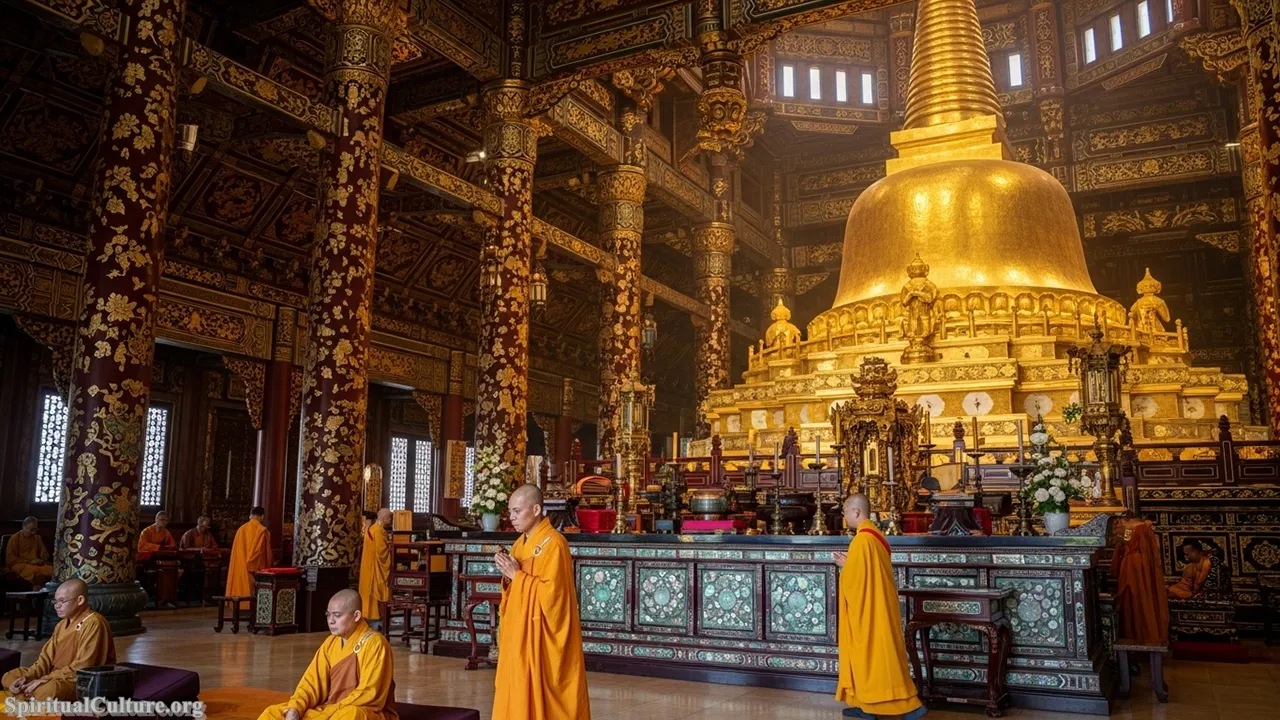
The spiritual significance of this temple is centered on the relic itself, which is housed in a magnificent stupa on the fourth floor and is central to Buddhist merit-making practices. Beyond the relic, the temple’s sheer scale and opulent design create a space of profound reverence and calm amidst the bustling city. It serves as a functional place of worship and a powerful symbol of the continuity of Mahayana Buddhism, providing a focal point for the spiritual life of Singapore’s largest ethnic group.
The temple’s dedication to education, housing a comprehensive Buddhist Culture Museum, ensures that its spiritual teachings are accessible to future generations. The moral lesson here is one of peaceful devotion and the quest for enlightenment. In a rapidly modernizing society, this temple stands as a commitment to ancient wisdom and the quiet resilience of faith, preserving the integrity of Buddhist art and practice.
Cultural/Spiritual Highlights
- Houses the revered relic, believed to be the left canine tooth of the Buddha.
- Built in the distinctive architectural style of the Chinese Tang Dynasty.
- Features a tranquil roof garden that offers a space for meditation and reflection.
#6. Kampong Glam Heritage District
Kampong Glam, historically the seat of Malay royalty and a bustling Muslim quarter, is a vital cultural artery for Singapore’s Malay and Arab communities. Characterized by vibrant street art, independent boutiques, and traditional shophouses, its popularity is driven by its authentic atmosphere and its role as a hub for Islamic and Malay culture, trade, and gastronomy. As of the Current Time of Writing, the district is celebrated for its successful blend of heritage preservation and contemporary creative energy.
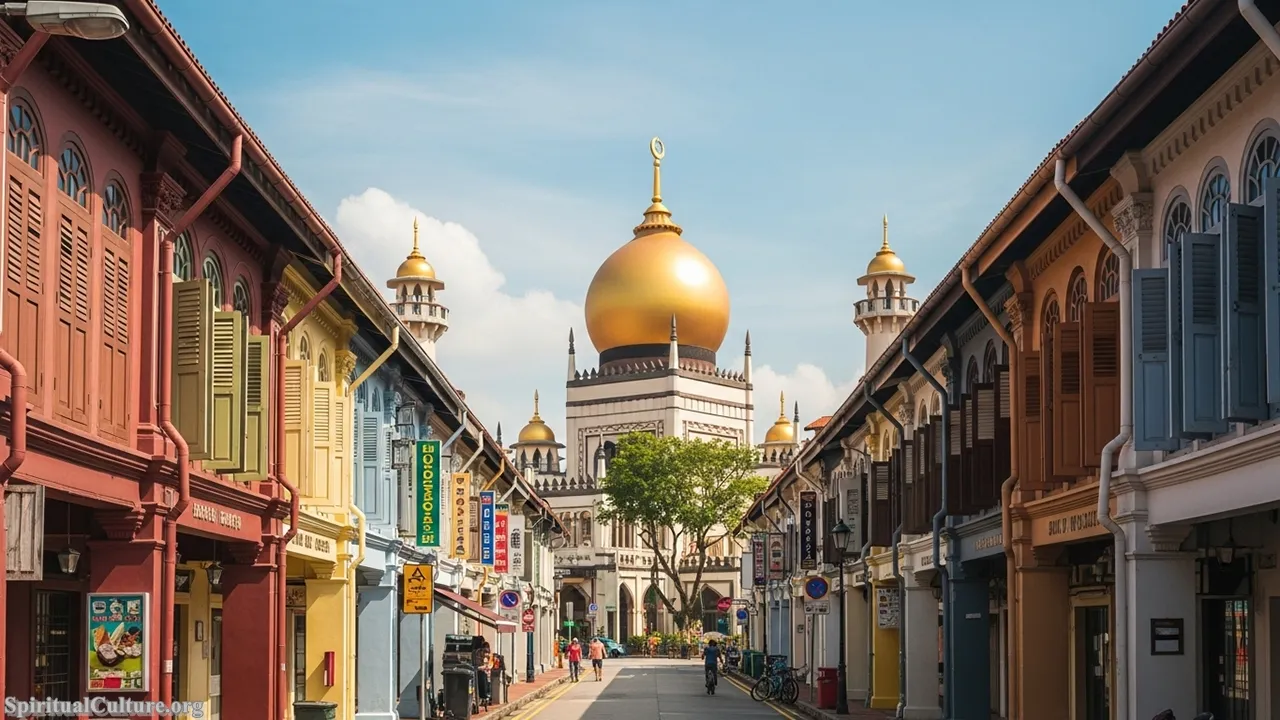
The spiritual heart of Kampong Glam is the majestic Sultan Mosque (Masjid Sultan), a gazetted National Monument with its imposing golden domes. The mosque is not only a place of daily prayer for the Muslim community but also an architectural symbol of the neighborhood’s historical importance as a pilgrimage and trading center. The spiritual impact is felt in the echoing call to prayer and the atmosphere of quiet reverence, anchoring the cultural life of the area in the tenets of Islam and the legacy of the Sultanate.
The district’s preservation is paramount, safeguarding the material and intangible heritage of the island’s indigenous community. It teaches a powerful lesson about community identity and resilience, where tradition is not static but evolves with the times, maintaining its spiritual core while embracing contemporary cultural expression. The Sultan Mosque, in particular, stands as a reminder of the historical foundations of Singapore’s multiracial society.
Cultural/Spiritual Highlights
- The Sultan Mosque’s gold domes are famously decorated at the base with glass bottle ends donated by Muslims during its construction.
- Was the original residence of the Malay Sultan Hussein Shah of Johor and his family.
- A hub for traditional Muslim practices, particularly vibrant during the holy month of Ramadan.
#5. National Museum of Singapore
As the oldest museum in Singapore, tracing its origins back to 1849, the National Museum of Singapore (NMS) is the definitive repository of the nation’s history, culture, and social narratives. Its popularity is rooted in its fundamental role in defining and communicating the Singaporean identity, welcoming millions annually to explore the chronological journey from a colonial trading post to a modern republic. Its commitment to innovative presentation ensures that historical understanding is not a dry exercise but an immersive and emotionally resonant experience.

The NMS’s spiritual significance lies in its role as a collective memory keeper. History is a form of spiritual anchor, providing context, meaning, and a shared sense of purpose. By documenting the sacrifices and triumphs of past generations, the museum fosters national cohesion and a sense of shared belonging, addressing the existential question of “Who are we?” The four majestic galleries of the Singapore History Gallery frame the narrative, guiding visitors through the critical junctures that shaped the nation’s moral and political consciousness.
The museum’s preservation value is absolute—it safeguards the tangible evidence of Singapore’s past. It imparts a profound moral lesson: that collective progress requires remembering the past, confronting hardship, and celebrating resilience. As the nation rapidly changes, the NMS provides the essential historical perspective necessary for a confident and grounded future.
Cultural/Spiritual Highlights
- The oldest museum in Singapore, providing an unbroken link to the nation’s history.
- Its permanent galleries use innovative technology to bring key historical periods to life.
- Houses the collection of Singapore History Gallery, which defines the nation’s collective identity.
#4. Little India Heritage District
Little India is Singapore’s most vibrant and authentic cultural enclave for the Indian community, a place where tradition, commerce, and spirituality vividly intertwine. As of the Current Time of Writing, it continues to pulse with life, from the scent of spices and flower garlands to the vibrant colors of its shophouses. Its popularity soars during festivals like Deepavali and Thaipusam, drawing not just the Indian diaspora but all who wish to immerse themselves in the deep-rooted cultural practices of the South Asian tradition.
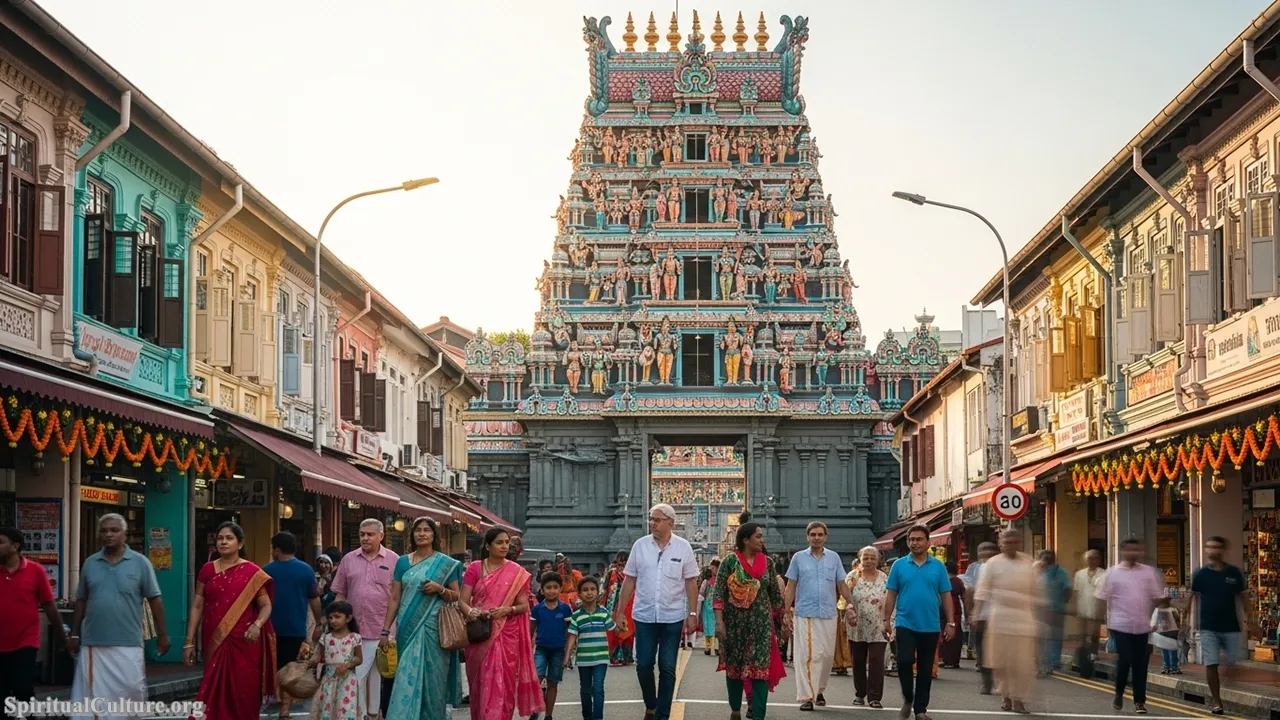
The district is a massive spiritual hub, anchored by magnificent temples such as the Sri Veeramakaliamman Temple and the Sri Srinivasa Perumal Temple. These Hindu sites are the focal points for major religious festivals, including the arduous and intensely spiritual Thaipusam procession. This makes it an essential pilgrimage site. The temples, adorned with intricate, colorful gopurams (entrance towers), stand as powerful testaments to the religious freedom and cultural resilience of the early Tamil laborers and traders.
Little India’s value is in its role as a living cultural landscape, faithfully preserving the Hindu and Indian cultural expressions that have flourished in Singapore for nearly two centuries. The enduring moral lesson here is the power of faith and devotion to sustain a community through migration and hardship. Its continued vibrancy is a celebratory demonstration of Singapore’s multicultural contract.
Cultural/Spiritual Highlights
- Key site for the annual Thaipusam procession, starting from Sri Srinivasa Perumal Temple.
- Sri Veeramakaliamman Temple is dedicated to the goddess Kali, known for protection and empowerment.
- The whole district is a commercial and spiritual hub for traditional Indian goods, food, and culture.
#3. Singapore Botanic Gardens
The Singapore Botanic Gardens stands out on this list as Singapore’s only UNESCO World Heritage Site, a recognition it achieved in 2015. Established in 1859, this sprawling tropical oasis has been a critical centre for botanical research, playing a pivotal role in the region’s 19th-century rubber trade boom. Its popularity transcends tourism; it is a beloved green lung for locals, offering a serene escape from the urban environment, a rarity for a major cultural landmark in a densely populated city-state.

The spiritual dimension of the Gardens is found in its commitment to conservation and its quiet, profound connection to nature. As a “sacred natural site,” the Gardens embody the spiritual principle of stewardship over the natural world. The act of walking through the ancient rainforest remnants or the tranquil National Orchid Garden is a form of passive meditation, allowing visitors to connect with the timeless rhythms of life and growth. It is a powerful reminder of nature’s fundamental role in human well-being and civilization.
Its World Heritage status ensures its perpetual preservation. The moral lesson the Gardens teach is one of patience, long-term vision, and the delicate balance between urban development and ecological necessity. It is the living testament to Singapore’s “City in a Garden” vision, proving that natural beauty and heritage can, and must, coexist with modernity.
Cultural/Spiritual Highlights
- Singapore’s first and only UNESCO World Heritage Site.
- Home to the National Orchid Garden, instrumental in Singapore’s ‘orchid diplomacy.’
- Features 6 hectares of ancient tropical rainforest, a rare, preserved ecosystem within a modern city.
#2. Chinatown Heritage District
Singapore’s Chinatown is the classic, historic enclave of the island’s majority ethnic group, a rich, multi-layered district that seamlessly blends the past with the present. As of the Current Time of Writing, it remains a bustling cultural hub, known for its traditional shophouses, street markets, and, most importantly, its remarkable array of religious sites. Its immense popularity is tied to its density of heritage, offering an immersive experience of the culture, food, and history of early Chinese pioneers.
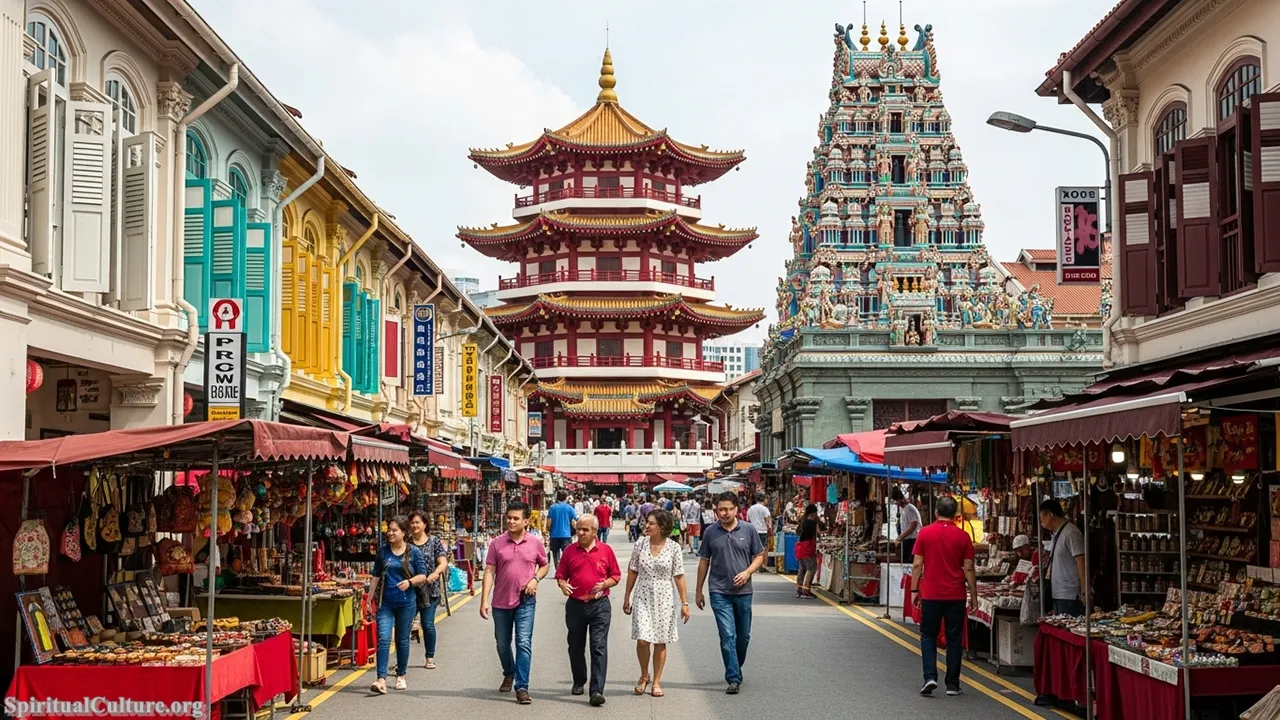
The spiritual depth of Chinatown is unparalleled. It is a microcosm of Singapore’s religious pluralism, featuring the Buddha Tooth Relic Temple, the venerable Thian Hock Keng Temple (dedicated to Mazu, the Sea Goddess), and the Sri Mariamman Temple (Singapore’s oldest Hindu temple) all within a few blocks. This physical proximity symbolizes the spiritual tolerance and intermingling that defined the early settlement. The district is a continuous site for festivals like Chinese New Year, ensuring that centuries-old spiritual and folk practices endure in public life.
The preservation of Chinatown’s architecture and street names ensures the memory of the early settlers’ struggles and resilience is never lost. The district serves as a powerful moral compass, illustrating how diverse faiths can peacefully coexist and support a robust community. It is a celebration of the enduring link between cultural heritage and spiritual practice.
Cultural/Spiritual Highlights
- The only district featuring major Chinese, Hindu, and Buddhist temples in close proximity.
- The Thian Hock Keng Temple (1839) is a National Monument and a key landing point for early Chinese immigrants.
- A central location for major cultural festivals, including the vibrant Chinese New Year celebrations.
#1. Gardens by the Bay
Gardens by the Bay, a colossal horticultural masterpiece, takes the top spot in the Spiritual Culture ranking for its sheer scale, symbolic power, and success in making the abstract concept of environmental stewardship a cultural phenomenon. Opening in 2012, this attraction, built on reclaimed land, is the ultimate expression of Singapore’s ‘City in a Garden’ philosophy. Its Supertree Grove and cooled conservatories (Flower Dome and Cloud Forest) draw the highest number of local and international visitors, making it Singapore’s most prominent cultural landmark as of the Current Time of Writing.
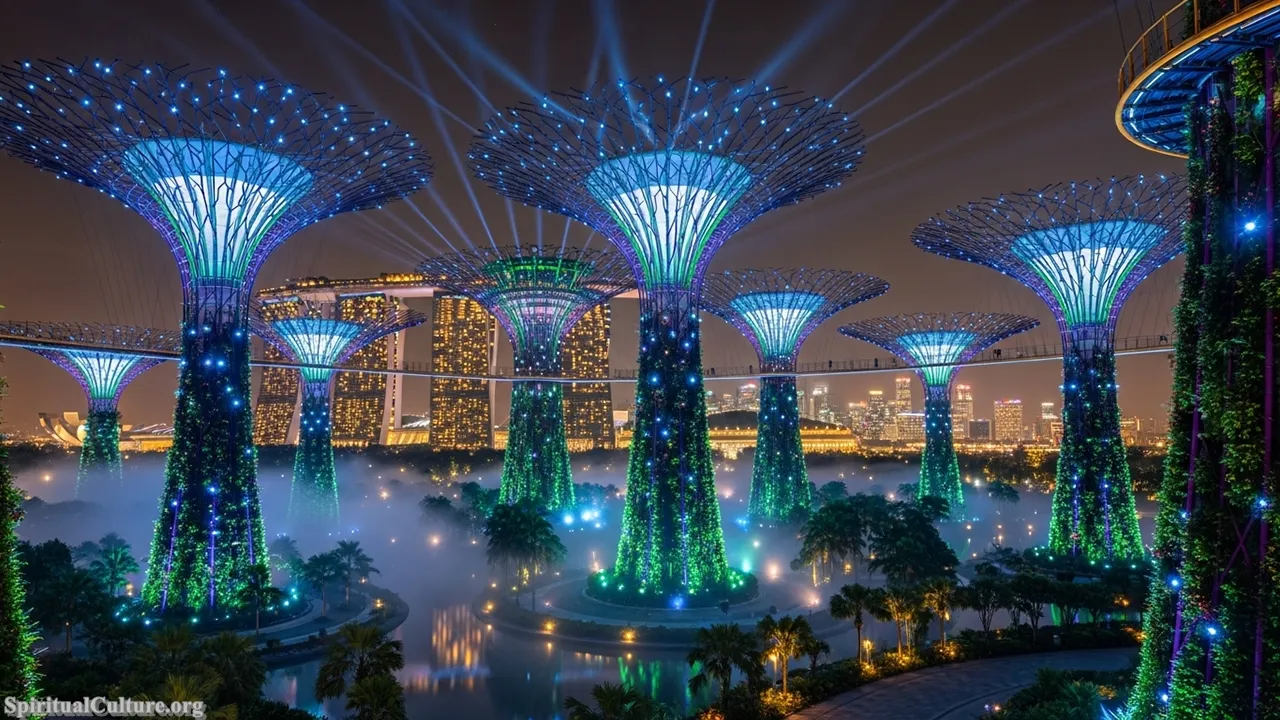
The spiritual impact here is profound, focusing on the connection between humanity, nature, and sustainability—a modern spiritual imperative. The spectacular Supertrees, which perform ecological functions and host the nightly light show, represent the aspiration to bridge technology and nature harmoniously. The Cloud Forest, with its colossal indoor waterfall, evokes a primal awe, creating a space for reflection on biodiversity and the fragility of the planet. This attraction makes a moral case for conservation, creating a sense of wonder that borders on the sacred.
Gardens by the Bay is a monument to Singapore’s national vision—a cultural asset that preserves a vision of a viable future. It offers the moral lesson that true progress is measured not just in economic growth, but in the harmony achieved between human civilization and the natural world. It is the nation’s boldest and most popular cultural declaration of its core values.
Cultural/Spiritual Highlights
- Symbolic realization of Singapore’s national vision to be a ‘City in a Garden.’
- The Cloud Forest conservatory simulates a mountain environment, cultivating spiritual awe and reflection on biodiversity.
- The Supertrees use vertical gardens to harvest energy and water, embodying the principle of sustainable living.
Conclusion
This Top 10 Spiritual Culture guide affirms that Singapore’s true genius lies not just in its economic miracle, but in its masterful cultivation of shared heritage and religious harmony. As the Current Time of Writing demonstrates, the most popular attractions are those that successfully merge historical narrative and spiritual meaning with modern accessibility.
From the futuristic environmental ethics celebrated at Gardens by the Bay to the enduring devotion found in the temples of Chinatown and Little India, these landmarks collectively tell a single, powerful story: that the Singaporean identity is a dynamic synthesis. It is a place where respect for ancient traditions (like the heritage districts) coexists with a bold, forward-looking commitment to global ideals (like the UNESCO-status Botanic Gardens). This delicate, yet resilient, balance between the past and the future is the profound spiritual culture that defines the Lion City.
We, at Spiritual Culture, celebrate this unique national accomplishment. These attractions are more than tourist sites; they are living reminders that unity in diversity is Singapore’s greatest cultural asset, a lesson in peaceful coexistence that serves as an inspiring beacon for the modern world. Preserving this rich tapestry is preserving the very soul of the nation, ensuring that the deeper meaning behind its greatness continues to enrich all who visit and call this island home.
